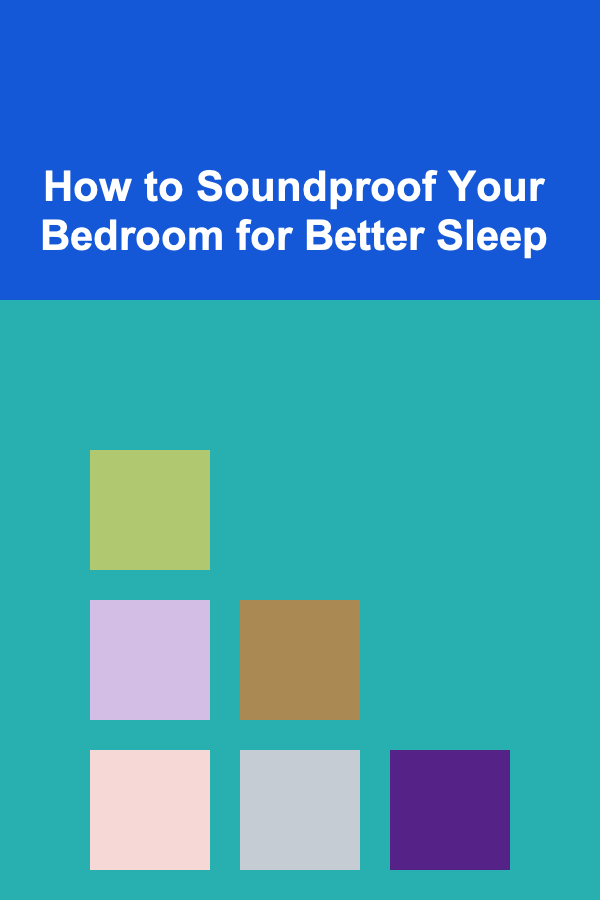
How to Soundproof Your Bedroom for Better Sleep
ebook include PDF & Audio bundle (Micro Guide)
$12.99$5.99
Limited Time Offer! Order within the next:

Getting quality sleep is essential for physical and mental well-being, but one of the most common obstacles to achieving restful slumber is noise. Whether it's traffic outside, noisy neighbors, or household sounds, external noise can disrupt your sleep cycle and reduce the overall quality of your rest. Soundproofing your bedroom is a practical solution that can help eliminate unwanted noise and create an environment conducive to better sleep.
In this article, we'll explore various techniques and strategies for soundproofing your bedroom, ranging from simple fixes to more advanced methods. By understanding how sound travels and applying the right materials and methods, you can significantly reduce noise pollution in your sleep space and improve your quality of sleep.
Understanding the Impact of Noise on Sleep
Before diving into how to soundproof your bedroom, it's important to understand why noise is such a significant sleep disruptor. Sound is known to affect the sleep cycle, particularly the stages of deep sleep and REM (Rapid Eye Movement) sleep, which are critical for restorative rest. Even relatively low levels of noise can cause micro-arousals during sleep, which are brief awakenings that occur without full consciousness.
These disruptions can lead to:
- Poor Sleep Quality: Interrupted sleep prevents your body from entering the deep stages of rest, leading to feelings of fatigue upon waking.
- Increased Stress: Persistent noise pollution can elevate stress levels, as the body remains in a semi-alert state, which hinders the relaxation necessary for quality sleep.
- Health Implications: Chronic noise exposure has been linked to higher risks of cardiovascular problems, mental health issues, and impaired cognitive function.
Given these factors, it's clear that reducing noise in your bedroom is vital for improving both the quality and quantity of your sleep. Now, let's explore how to soundproof your bedroom effectively.
Step 1: Identify the Source of the Noise
The first step in soundproofing your bedroom is identifying the primary sources of noise. This will help you understand how to address the issue more effectively. Common sources of noise in a bedroom include:
- External Noise: Traffic, sirens, pedestrians, or construction sounds from outside.
- Internal Noise: Sounds from other rooms, appliances, or even from within the bedroom itself (e.g., squeaky floorboards or rattling windows).
- Noise from the Walls: If you share walls with a neighbor, sounds can travel through the walls into your room.
- HVAC and Air Conditioning Units: Mechanical noises from air conditioning units, fans, or heaters can also contribute to disruptive sound.
Once you identify where the noise is coming from, you can select appropriate soundproofing solutions to target those areas.
Step 2: Seal the Gaps Around Doors and Windows
A significant amount of noise can enter your bedroom through gaps and cracks around doors and windows. Sound travels through these openings, so sealing them effectively is one of the simplest ways to reduce noise intrusion.
Door Soundproofing
- Weatherstripping: Installing weatherstripping around the edges of your door is a quick and affordable way to block sound. Weatherstripping materials, such as foam or rubber, expand to fill the gaps around the door, preventing noise from leaking through.
- Door Sweep: A door sweep is installed at the bottom of the door to seal the gap between the door and the floor. This is especially effective for blocking noise from the hallway or outside the room.
- Solid Core Door: If your bedroom door is hollow or lightweight, consider replacing it with a solid core door. Solid doors, made from dense materials like wood or MDF, are much more effective at blocking sound than hollow doors.
Window Soundproofing
- Window Inserts: These are clear acrylic or glass panels that fit over your existing windows to add an extra layer of soundproofing. They are an excellent solution for blocking external noise, especially in noisy urban environments.
- Double-Glazed Windows: If you're in a position to replace your windows, double-glazed windows provide significant noise reduction. The two layers of glass create an air gap that dampens sound vibrations.
- Heavy Curtains: Thick, heavy curtains, often referred to as soundproof curtains, can also help to block noise. The denser the fabric, the more effective it will be at absorbing sound. Heavy drapes also have the added benefit of blocking light, creating a more conducive sleep environment.
- Acoustic Caulk: Apply acoustic caulk around the edges of your windows and doorframes. This helps to seal gaps and cracks where sound can seep through, providing additional noise reduction.
Step 3: Use Soundproofing Materials on Walls
If your bedroom shares walls with noisy neighbors, soundproofing the walls can significantly reduce the noise that enters the room. There are various materials and techniques that can help to block or absorb sound.
Acoustic Panels
Acoustic panels are a popular solution for reducing sound transmission. These panels are made from materials such as foam or fiberglass and are designed to absorb sound. When placed on the walls, they can effectively reduce noise by preventing sound waves from bouncing off hard surfaces and reverberating in the room. Acoustic panels come in different shapes, sizes, and styles, so you can choose one that suits your bedroom décor.
Mass-Loaded Vinyl (MLV)
Mass-loaded vinyl is a dense, flexible material that is designed to block sound. MLV can be attached to walls, ceilings, and even floors to reduce sound transmission. It works by adding mass to the structure, which helps to prevent sound from traveling through it. MLV is particularly effective when combined with other soundproofing materials, such as acoustic foam or drywall.
Soundproofing Drywall
For more significant noise reduction, you can replace or add layers of soundproof drywall to your existing walls. Soundproof drywall is denser than regular drywall and contains materials that absorb sound vibrations. It's more expensive than other methods but offers a long-term solution for dealing with persistent noise.
Step 4: Flooring Solutions for Noise Reduction
The type of flooring in your bedroom can also play a role in soundproofing. Hard floors, such as wood, tile, or laminate, can reflect sound and increase noise levels. To reduce sound transmission through the floor, consider the following options:
Area Rugs
If you have hardwood or tile floors, placing large area rugs or carpets in your bedroom can help to absorb sound and reduce noise. Thick, plush rugs made from natural fibers, like wool, are especially effective at dampening sound.
Acoustic Underlayment
If you're in the process of replacing your flooring, consider adding acoustic underlayment beneath carpet or hardwood flooring. Acoustic underlayment is made from materials like foam, cork, or rubber and helps to reduce sound transmission between floors.
Cork Flooring
Cork is an excellent sound-absorbing material that can be used as both a flooring option and underlayment. Cork floors are softer than hardwood or tile, which helps to reduce noise, particularly impact noises like footsteps.
Step 5: Use Soundproofing in the Ceiling
If you live in an apartment or a multi-story home, noise from the ceiling can be a significant concern. Soundproofing your ceiling can help prevent noise from rooms above you from disturbing your sleep.
Acoustic Tiles
Acoustic ceiling tiles are designed to absorb sound and reduce the amount of noise that travels between floors. These tiles are often used in office environments but can be applied to residential settings as well. They are particularly effective in reducing reverberation and echo in rooms with high ceilings.
Mass-Loaded Vinyl on the Ceiling
Mass-loaded vinyl can also be applied to the ceiling to block sound. When combined with other materials like acoustic tiles or drywall, MLV offers a robust solution for ceiling soundproofing.
Step 6: Consider White Noise or Sound Masking
While soundproofing your bedroom will go a long way in blocking unwanted noise, there may still be times when you need a little extra help to mask residual sounds. White noise machines or sound masking devices can help create a consistent auditory environment, making it easier to sleep through occasional disruptions.
White noise works by producing a constant, neutral sound (like static or ocean waves) that masks other noises. By masking background sounds, white noise makes them less noticeable and less likely to disrupt your sleep. You can also use sound masking apps on your smartphone or opt for a high-quality sound machine for more consistent sound coverage.
Step 7: Maintain a Quiet Bedroom Environment
Beyond soundproofing the physical space, creating a quiet environment also involves minimizing noise within the bedroom itself. This can be achieved by:
- Turning off electronics: Electronics like TVs, computers, and smartphones can produce beeping, buzzing, or humming sounds, so it's a good idea to turn them off before going to bed.
- Minimizing movement: Avoid slamming doors or making loud noises that can disturb your sleep.
- Using gentle alarm clocks: Consider using a vibrating alarm clock or one with a soft, gradual sound to avoid waking up with a jarring noise.
Conclusion
Soundproofing your bedroom is one of the most effective ways to improve your sleep quality. Whether you're dealing with external noise from traffic or internal disturbances from noisy neighbors or housemates, there are numerous strategies available to create a quieter environment. By combining techniques like sealing gaps, using soundproofing materials, and incorporating noise-masking methods, you can significantly reduce the impact of noise and enhance the quality of your rest. Taking the time to soundproof your bedroom not only helps you sleep better but also promotes overall health and well-being.
Reading More From Our Other Websites
- [Home Maintenance 101] How to Maintain a Historic Home: Preserving Its Charm
- [Home Soundproofing 101] How to Soundproof a Music Studio at Home for Professional-Grade Sound Isolation
- [Organization Tip 101] What Are the Most Efficient Ways to Organize Your Shopping List?
- [Home Party Planning 101] How to Document Your Party for Social Media Sharing
- [Home Cleaning 101] How to Tackle Pet Hair Everywhere in Your Home
- [Home Renovating 101] How to Renovate Your Home on a Tight Budget and Still Get Great Results
- [Organization Tip 101] How to Create a Personalized Study Environment
- [Organization Tip 101] How to Use Pinterest for Recipe Organization and Inspiration
- [Personal Care Tips 101] How to Create a Long-Lasting Glossy Lip Look with Lip Gloss
- [Organization Tip 101] How to Teach Kids About Pantry Organization

How to Host a Stylish Garden Party in Your Own Backyard
Read More
How to Organize Your Cleaning Routine to Save Time
Read More
How to Stage Your Home for Winter to Create a Cozy Environment
Read More
How to Use Indexing for Quick Document Retrieval
Read More
How To Play Simulation Games for Immersion
Read More
How to Optimize Your React Performance with Profiling Tools
Read MoreOther Products

How to Host a Stylish Garden Party in Your Own Backyard
Read More
How to Organize Your Cleaning Routine to Save Time
Read More
How to Stage Your Home for Winter to Create a Cozy Environment
Read More
How to Use Indexing for Quick Document Retrieval
Read More
How To Play Simulation Games for Immersion
Read More